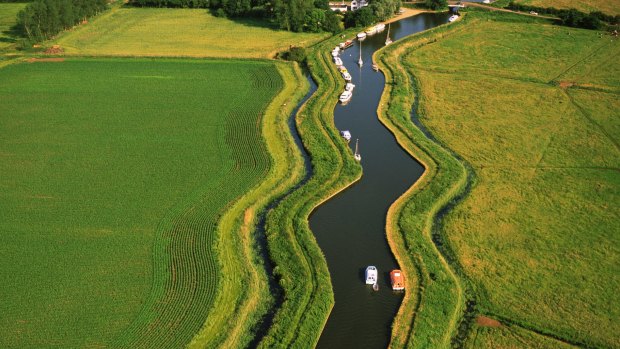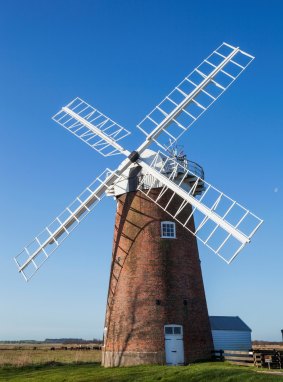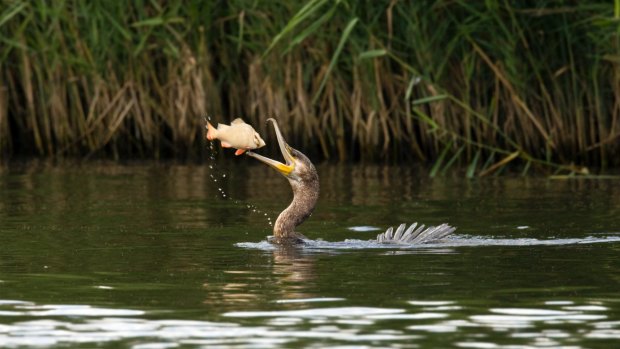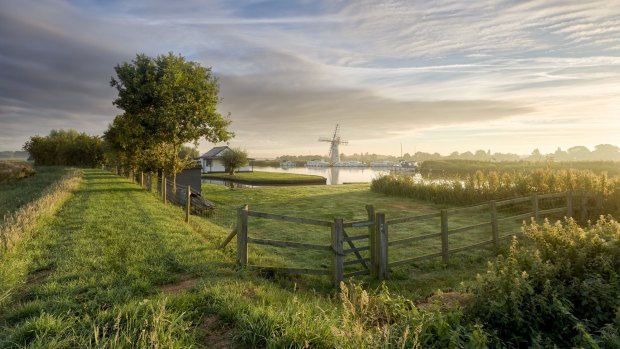This was published 7 years ago
River cruises: Private boat hire on the Norfolk Broads, England
By Steve Meacham

An aerial view of the Norfolk Broads at Ludham Bridge, Norfolk.Credit: Getty Images
Where I grew up in England is about as far from the coast as you can get in Britain. And my most desperate wish as a child was that our family – Mum, Dad and five kids – could go boating on the Norfolk Broads.
Admittedly, "the Broads" weren't "abroad". But each year, between the ages of 10 and 14, I would cut out advertisements in the Sunday papers and leave them for my parents to find.
Sadly, they never noticed them. Or if they did, they never booked us aboard those sleek motor cruisers which seemed the epitome of cool in the early '60s.

We pass iconic windmills built to crush grainsCredit: Getty Images
Fast forward 50 years and my dearest travel dream is being realised. My two Australian sons (14 and 12) and I are being given our 30-minute induction course aboard Jamaica – a '60s-looking, eight-berth cruiser we've hired for five days from Richardsons boatyard in Stalham, at the northern edge of the Broads.
We are shown how to start, steer, stop and (most importantly) how to reverse Jamaica so we can moor it safely stern-on when we pull up at one of the many waterfront pubs that provide overnight mooring spots.
For once, my sons pay attention because they know they can take the helm (under adult supervision) – which is half the fun of their nautical adventure.

We spot countless bird species, from heron to kingfishers, crane to marsh harriers.Credit: Getty Images
But on this first afternoon, as we slide back Jamaica's sun roof on this sublime autumn day and chug our way at six knots along Slatham Dyke and Sutton Broad, we're heading to our first nautical challenge.
It takes us 30 minutes to reach the Sutton Staithe Hotel, but it's now 5pm and one of the rules of Broads boating is that every vessel must be tied up before sunset. We also know mooring spots by any waterside pub get scarce.
Of course, you don't need to spend the night near a hostelry. Many Broads veterans prefer to find somewhere isolated to tie up for the night, having had the wisdom to stock up on provisions.

The River Thurne on the Broads National Park. Credit: Getty Images
But as we walk up the towpath for our first pub supper of the cruise, I'm in heaven. The three of us have managed to moor without ramming another boat, and without a mutiny.
Next morning, after a blissful slumber soothed by the gentle rocking of Jamaica, the boys are keen to cast off early because we have arranged to meet some of their British relatives – my widowed Dad and my two brothers – for lunch at the Bridge Inn, Acle. And that is a good three hours south.
My Dad and brothers have accepted my invitation to join the crew for the next two days ("Captain Pugwash" was mentioned). My two sisters were also invited, but declined ("Captain Bligh" was mentioned).
So the boys share the helm as we cruise through the towering reed beds to our rendezvous. It's 21 kilometres by water – via Barton Broad, the River Ant, and the River Bure – from Sutton to Acle (just 12 kilometres as the crow flies).
Sure enough, my 85-year-old father and two brothers are waiting for us on the riverbank, eager to criticise our mooring.
Over lunch, we discuss our voyage. "We can go further east to Great Yarmouth, visit the pier and have a bracing dip in the North Sea," I say, showing them the map. "Then we can head south-west via Breydon North Flats to Suffolk.
"Or we could just opt for safety and head back up the River Bure?"
Our mooring must have looked worse than I thought, because Dad and my brothers immediately opt for upstream safety.
Though Arthur Ransome's classic Swallows and Amazons novels are mostly associated with the Lake District, two – The Coot Club and The Big Six – were set on the Broads. Re-reading them on Jamaica, the landscape has barely changed since the 1930s.
Over the next few days, our company of six (and to be honest, it would have been difficult to fit my sisters aboard Jamaica comfortably) witness a huge variety of protected habitats.
There is the unique and internationally vital network of reed beds, grazing marshland, fens, wet woodland and open water.
We spot countless bird species, from heron to kingfishers, crane to marsh harriers, swans to pink-footed geese (though we don't witness the exquisitely named bearded tit).
We pass windmills built to crush grains and later converted to drain flood-vulnerable land.
There are quaint villages still dominated by ancient churches whose towers or spires stand out like beacons from the pancake flat countryside. There are hundreds of thatched houses (made from the reed beds which were once this region's principle revenue earner until the introduction of the roof tile to Britain).
And we slow Jamaica each time we round a bend and encounter a Norfolk wherry – the large, single-sailed, shallow-draught craft that was specifically designed for the Broads.
For 200 years, wherries transported goods between ocean ports like Great Yarmouth and Norwich – Norfolk's county capital and the most westerly port on the Broads.
If you're wondering why it took Norwich so long to make use of its position on the Broads, there is a simple answer. Contrary to the popular opinion of the millions of tourists who visit each year thinking they're visiting a pristine natural environment, the Broads (which actually straddle Norfolk and Suffolk) are man-made.
During the Middle Ages, when the area's population was growing rapidly, the plentiful trees of the region were felled for fuel. Once the trees were gone another source of cooking and heating was needed. So the locals dug deep peat pits by the existing rivers – and, when those wide pits eventually flooded, the Broads were born.
Back on Jamaica, there is a slight navigational glitch when we discover the tide is so high we can't get under the bridge to reach Hickling Broad, our original overnight target.
Not to worry, we head south again and find a mooring at Thurne Dyke alongside the Lion Inn.
Next morning we head west along the River Bure, stopping to explore the picturesque ruins of St Benet's Abbey, the last resting place of Sir John Fastolf – an English knight in the 100 Years War who is said to be the inspiration for Shakespeare's Falstaff.
This becomes the pattern for the next few days. Wonderful views, old-fashioned board games, thwarted itineraries, snippets of English heritage – and lots of cross-generational laughs (mainly at my expense).
This, I now realise, is one of the fundamental wisdoms of a relaxing holiday on the Broads. Have a plan. Choose an overnight mooring spot. If that's unattainable, be adaptable. And if all else fails, have enough provisions so you can moor well away from "civilisation" and just enjoy a meal under the star-lit splendour of Norfolk's night sky.
One morning, while the rest of the party are reading their papers, my youngest son and I venture out on a pre-breakfast walk along the wildlife track to Ranworth Broad with its excellent interpretative signs and floating "hide".
He is desperate to see an otter, which has made a spectacular return to the Broads in recent years. We don't see one, but we have a good chat and he says he'd love to return to the Broads one day.
As for my Dad, I finally ask the tough question on our last day: "Don't you wish you'd brought us to the Broads when I kept leaving all those adverts for you when I was a kid?"
"Why didn't you tell me?" he says, astonished. "I never knew you wanted to come here."
DRIVE
Stalham is 225 kilometres north-east of London. Allow three hours by car via the M11 and A11. Trains run from London Liverpool Street station to Norwich, with bus connections to Stalham.
STAY
Richardson's Boating Holidays, based at Stalham boatyard, offers a two-night break from £290. See richardsonsboatingholidays.co.uk/
FLOAT
You'll need to pay a fuel deposit. Ours was £75, but we received a rebate of £25 for the fuel we didn't use.
Steve Meacham and family travelled at their own expense.
Sign up for the Traveller Deals newsletter
Get exclusive travel deals delivered straight to your inbox. Sign up now.